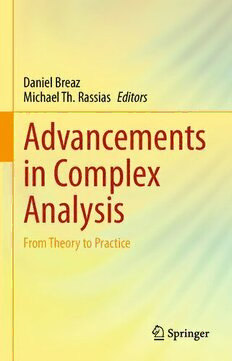Table Of ContentDaniel Breaz
Michael Th. Rassias Editors
Advancements
in Complex
Analysis
From Theory to Practice
Advancements in Complex Analysis
Daniel Breaz • Michael Th. Rassias
Editors
Advancements in Complex
Analysis
From Theory to Practice
Editors
DanielBreaz MichaelTh.Rassias
“1Decembrie1918” InstituteofMathematics
UniversityofAlbaIulia UniversityofZurich
AlbaIulia,Romania CH-8057Zurich,Switzerland
MoscowInstituteofPhysicsandTechnology
Institutskiyper,d.9
141700Dolgoprudny
Moscow,Russia
InstituteforAdvancedStudy
PrograminInterdisciplinaryStudies
1EinsteinDr,
Princeton,NJ,USA
ISBN978-3-030-40119-1 ISBN978-3-030-40120-7 (eBook)
https://doi.org/10.1007/978-3-030-40120-7
MathematicsSubjectClassification:11-XX,26-XX,28A10,30-XX,32-XX,33-XX,35-XX,37-XX,
39B32,60-XX,65Exx,74S70,76M40
©SpringerNatureSwitzerlandAG2020
Thisworkissubjecttocopyright.AllrightsarereservedbythePublisher,whetherthewholeorpartof
thematerialisconcerned,specificallytherightsoftranslation,reprinting,reuseofillustrations,recitation,
broadcasting,reproductiononmicrofilmsorinanyotherphysicalway,andtransmissionorinformation
storageandretrieval,electronicadaptation,computersoftware,orbysimilarordissimilarmethodology
nowknownorhereafterdeveloped.
Theuseofgeneraldescriptivenames,registerednames,trademarks,servicemarks,etc.inthispublication
doesnotimply,evenintheabsenceofaspecificstatement,thatsuchnamesareexemptfromtherelevant
protectivelawsandregulationsandthereforefreeforgeneraluse.
Thepublisher,theauthorsandtheeditorsaresafetoassumethattheadviceandinformationinthisbook
arebelievedtobetrueandaccurateatthedateofpublication.Neitherthepublishernortheauthorsor
theeditorsgiveawarranty,expressedorimplied,withrespecttothematerialcontainedhereinorforany
errorsoromissionsthatmayhavebeenmade.Thepublisherremainsneutralwithregardtojurisdictional
claimsinpublishedmapsandinstitutionalaffiliations.
ThisSpringerimprintispublishedbytheregisteredcompanySpringerNatureSwitzerlandAG
Theregisteredcompanyaddressis:Gewerbestrasse11,6330Cham,Switzerland
Preface
This volume presents papers devoted to a broad spectrum of areas of Complex
Analysis,rangingfrompuretoappliedandinterdisciplinarymathematicalresearch.
Topicstreatedwithinthisbookincludeholomorphicapproximation,hypercomplex
analysis, special functions of complex variables, automorphic groups, zeros of
the Riemann zeta function, Gaussian multiplicative chaos, non-constant frequency
decompositions, minimal kernels, one-component inner functions, power moment
problems,complexdynamics,biholomorphiccryptosystems,fermionicandbosonic
operators.
Thepapershavebeencontributedbyexpertsfromtheinternationalcommunity,
who have presented the state-of-the-art research in the corresponding problems
treated. Effort has been made for the present volume to be a valuable source for
bothgraduatestudentsandresearchmathematiciansaswellasphysicists,engineers
andscientistsconductingresearchinrelatedinterdisciplinarysubjects.
Wewouldliketoexpressourwarmestthankstoalltheauthorsofpapersinthis
volumewhocontributedinthiscollectiveeffort.Lastbutnotleast,wewouldliketo
extendourappreciationtotheSpringerstafffortheirvaluablehelpthroughoutthe
publicationprocessofthiswork.
AlbaIulia,Romania DanielBreaz
Zurich,Switzerland MichaelTh.Rassias
v
Contents
ATheoryonNon-ConstantFrequencyDecompositions
andApplications ................................................................. 1
QiuhuiChen,TaoQianandLihuiTan
One-ComponentInnerFunctionsII ........................................... 39
JosephCimaandRaymondMortini
BiholomorphicCryptosystems.................................................. 51
NicholasJ.Daras
Third-OrderFermionicandFourth-OrderBosonicOperators ............ 105
ChaoDing,RaymondWalter,andJohnRyan
HolomorphicApproximation:TheLegacyofWeierstrass,Runge,
Oka–Weil,andMergelyan ...................................................... 133
JohnErikFornæss,FrancForstnericˇ,andErlendF.Wold
APotapov-TypeApproachtoaTruncatedMatricialStieltjes-Type
PowerMomentProblem......................................................... 193
BerndFritzsche,BerndKirstein,ConradMädler,andTatsianaMakarevich
FormulasandInequalitiesforSomeSpecialFunctions
ofaComplexVariable........................................................... 299
ArcadiiZ.Grinshpan
OntheMeansoftheNon-trivialZerosoftheRiemannZetaFunction.... 319
MehdiHassani
MinimalKernelsandCompactAnalyticObjectsinComplexSurfaces ... 329
SamueleMongodiandGiuseppeTomassini
OntheAutomorphicGroupofanEntireFunction .......................... 363
RonenPeretz
vii
viii Contents
IntegralRepresentations inComplexAnalysis:FromClassical
ResultstoRecentDevelopments................................................ 449
R.MichaelRange
OntheRiemannZetaFunctionandGaussianMultiplicativeChaos ...... 473
EeroSaksmanandChristianWebb
SomeNewAspectsinHypercomplexAnalysis................................ 497
WolfgangSprößig
SomeConnectionsofComplexDynamics..................................... 519
AlexandreDeZotti
A Theory on Non-Constant Frequency
Decompositions and Applications
QiuhuiChen,TaoQian,andLihuiTan
Abstract Positive time-varying frequency representation of transient signals has
beenaheartydesireofsignalanalystsduetoitstheoreticalandpracticalimportance.
During approximately the last two decades there has been formulated a signal
decompositionandreconstructionmethodrootinginharmonicandcomplexanaly-
sis and giving rise to the desired signal representation. The method decomposes a
signalintoafewbasicsignalsthatpossesspositive-instantaneousfrequencies.The
theoryhasprofoundrelationswithclassicalmathematicsandcanbegeneralizedto
signals defined in higher dimensions with vector or matrix values. Such represen-
tations, in particular, promote rational approximations in higher dimensions. This
articlemainlyservesasasurvey.Italsogivesanewproofofageneralconvergence
result,aswellasaproofofaresultconcerningmultipleselectionsoftheparameters.
Expositorily,foragivenreal-valuedsignalf onecanassociateitwithaHardy
space function F whose real part coincides with f. Such function F has the form
F = f +iHf, where H stands for the Hilbert transformation of the context. We
developfastconvergingexpansionsofF inorthogonaltermsoftheform
Tao Qian supported by Research Grant of University of Macau FDCT 079/2016/A2, FDCT
0123/2018/A3
LihuiTansupportedbyNationalNaturalScienceFoundationofChina(Grantno.61471132)
Q.Chen
FacultyofMathematicsandInformatics,SouthChinaAgriculturalUniversity,Guangzhou,China
e-mail:[email protected]
T.Qian((cid:2))
MacauInstituteofSystemsEngineering,MacauUniversityofScienceandTechnology,Macau,
China
e-mail:[email protected]
L.Tan
SchoolofAppliedMathematics,GuangdongUniversityofTechnology,510006Guangzhou,P.R.
China
e-mail:[email protected]
©SpringerNatureSwitzerlandAG2020 1
D.Breaz,M.Th.Rassias(eds.),AdvancementsinComplexAnalysis,
https://doi.org/10.1007/978-3-030-40120-7_1
2 Q.Chenetal.
(cid:2)∞
F = c B ,
k k
k=1
whereB ’sarealsoHardyspacefunctionsbutwiththeadditionalproperties
k
B (t)=ρ (t)eiθk(t), ρ ≥0, θ(cid:4)(t)≥0, a.e.
k k k k
Theoriginalreal-valuedfunctionf isaccordinglyexpanded
(cid:2)∞
f = ρ (t)cosθ (t)
k k
k=1
which,besidesthepropertiesofρ andθ givenabove,alsosatisfiestherelation
k k
H(ρ cosθ )(t)=ρ (t)sinθ (t).
k k k k
Real-valuedfunctionsf(t)=ρ(t)cosθ(t)thatsatisfythecondition
ρ ≥0, θ(cid:4)(t)≥0, H(ρcosθ)(t)=ρ(t)sinθ(t)
are called mono-components. Phase derivative in the above definition will be
interpreted in a wider sense. If f is a mono-component, then the phase derivative
(cid:4)
θ (t) is defined to be instantaneous frequency of f. The above defined positive-
instantaneous frequency expansion is a generalization of the Fourier series expan-
sion.Mono-componentsarecrucialtounderstandtheconceptofinstantaneousfre-
quency.Wewillpresentseveralmostimportantmono-componentfunctionclasses.
Decompositions of signals into their principal or intrinsic mono-components are
called adaptive Fourier decompositions (AFDs). We note that some scopes of the
studyofthe1Dmono-components andAFDscanbeextended tovector-valued or
even matrix-valued signals defined on higher dimensional manifolds. We provide
an account of the related studies in pure and applied mathematics, and in signal
analysis,aswellasapplicationsofthedevelopedtheory.
1 Introduction
Itisacommonsenseamonganalyststhat“Thestudyontheunitcircleisharmonic
analysis;andinsidetheunitcircleiscomplexanalysis”,andthesameistruefora
manifold and its neighborhood regions. In general, the following mechanism may
be regarded as complex analysis method of harmonic analysis. When studying
analysis on the boundary of a region, say, for instance, in an Euclidean space,
one can at the cost of one more (or p-more) dimension (dimensions), imbed the
region together with its boundary into a larger space, where the latter is equipped
ATheoryonNon-ConstantFrequencyDecompositionsandApplications 3
with a Cauchy complex structure, including essentially the Cauchy theorem, the
Cauchy kernel, and the Cauchy formula. That is, one treats the boundary of the
region as a co-dimension 1 (or co-dimension p +1) manifold in the larger space
with a Cauchy structure. With the complex structure one can define complex
Hardyspaces consistingofsuitablecomplex holomorphicfunctions intheregions
divided by the manifold. Here by “suitable” we mean, in particular, the complex
Hardy functions defined in the regions having non-tangential boundary limits as
projections into the corresponding function spaces on the manifold. Conversely,
functions in suitably defined function classes on the manifold can be made to be
associatedwiththosenon-tangentialboundarylimits,thelatterbeingcalledanalytic
signals.ThoseideasappearedinthelecturesofM.-T.ChengandD.-G.Denggiven
inBeijingUniversity[12],inthebookofGorusintranslatedbyJ.-G.Chen[38],in
works of A. McIntosh and, separately, of C. Kenig and other authors, on complex
Hardy spaces, singular integrals, boundary value problems and related topics on
Lipschitz curves and surfaces. This article serves as a survey on the study that the
author and his collaborators have been undertaking by implementing the complex
analysismethodtoharmonicandsignalanalysis.
The study can be divided into two parts of which one is mono-component
functiontheory,studyingsignalspossessinganon-negativeinstantaneousfrequency
function; and the other is approximation to analytic functions by using mono-
components. Note that the monomials zn,n = 0,1,··· , are particular cases
of mono-components, and the Fourier series expansion is a mono-component
approximation. The study that we are going to explore is generalization of the
Fourier theory in relation to the scope of the Beurling–Lax theorem involving
forwardshiftandbackwardshiftinvariantsubspaces.
Thestudyatbeginningwasmotivatedbythetentativedefinitionoftheconcept
instantaneousfrequency(IF),or,inbrief,thefrequencyfunction,byGabor[33].The
conceptinstantaneousfrequencyis,sofar,stillonetobeacceptedbysignalanalysts.
People tend to believe that for a general signal there is a certain “frequency” at
eachmomentoftime.Thisbeliefissupportedbysinusoidalfunctionsthatpossess
constant frequencies. Justification of existence of a frequency function crucially
depends on how to define IF. Unfortunately, the IF concept itself appears to be
paradoxical: “frequency” is the oscillation number (or in the averaging sense)
per unit time duration, hence a time interval is required in order to determine it;
while“instantaneous”involvesonlyatimemoment.Agreatvarietyofengineering
definitions of IF have been proposed those, in the author’s opinion, are mostly
vague or self-contradictory. None of the existing theories, nor the applications,
are satisfied [8, 13]. It is believed that there does not exist an anticipated IF
conceptforageneralsignal.Onecan,however,proposeamathematicaldefinition
ofinstantaneousfrequencybasedonwhichsignalscanbeeffectivelyanalyzed.The
proposeddefinitionofIFisbasedontheMöbiustransform.Acoherenttheorythat
has close and profound relations with the classical analysis and great potential in
applications hasbeeninitialized.AsanewtrendofFourieranalysisitemphasizes
onnon-linearphasephenomenon,consistingoftwoparts:definingtheIFconcept,
and decomposing a general signal into those possessing IF. We call the signals

